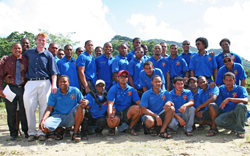You are here » Home » Telling Our Story
Case Study
Local tour guides learn how to manage a natural treasure
Building an Eco-Tourism Enterprise

| |
Photo: USAID/Anabelle Soto
|
|
USAID and Peace Corps volunteers pose with members of the Damajagua River Guide Association after a training session.
Guides are required to complete training sessions that teach how to keep visitors safe and protect the delicate river environment.
|
Challenge
The 27 Charcos National Monument is a series of waterfalls along the Damajagua River in Llanos de Perez, a small town near the northern Dominican shore. Tourists would visit the environmental wonder on their own or with inexperienced guides. As a result, a natural treasure was being polluted and mismanaged and a golden opportunity for generating tourism revenue was being squandered. A local group of guides, the Damajagua River Guide Association, lacked the legal authority, know-how, and funds to turn the site into a successful eco-tourism enterprise. But they knew that if they could solve these problems, it would mean more income for the community and safer visits for tourists, who frequently injured themselves on the way to the waterfalls.
Initiative
USAID worked with the association to create an effective river management and guide training plan. With backing from USAID and a concrete plan of action, the project gained support from the local government and residents, who would themselves benefit from the initiative if it was a success. Municipal authorities donated machinery to build safer trails to the waterfalls, while Peace Corps volunteers trained the guides in how to safely manage and lead groups of tourists to the river.
Results
In November 2005, the Damajagua River Guide Association gained the legal status it sought: the environmental ministry granted the association the power to establish a system of rules and regulations to protect both the monument and tourists. Under the agreement, guides must be trained regularly in both visitor safety and environmental sensitivity. Tourists now pay a fee to visit the river, which brings higher pay to the guides. Profits from the fees are used for local development projects. With a professionally-run and safe eco-tourism site, everyone benefits — tourists, local guides, and even the river.
Print-friendly version of this page (427kb - PDF)
Click here for high-res photo
Back to Top ^ | 

